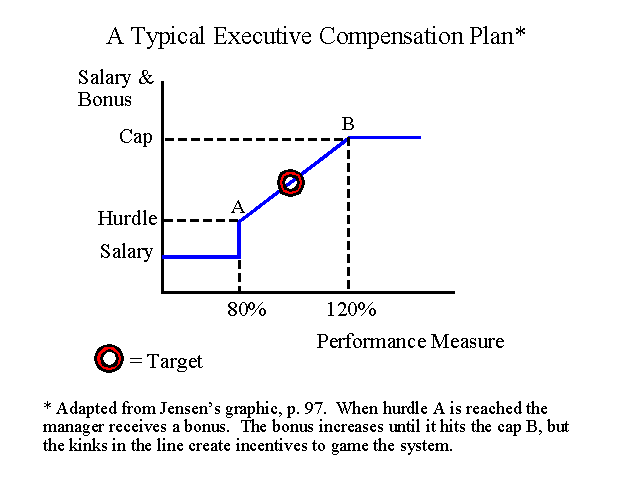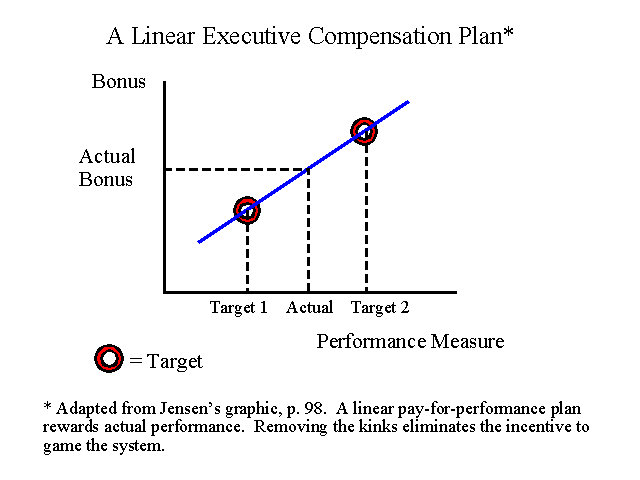
Summary by David Lamb
Master of Accountancy Program
University of South Florida, Summer 2003
Agency Theory Main Page | Behavioral
Issues Main Page | Budgeting Main Page
This article is easily summarized in one sentence. “Employee compensation packages should never be linked to budgeting targets; instead, companies should utilize a purely linear bonus schedule.”
To be more specific, Jensen feels that basing bonuses on a manager's ability to achieve budget targets is counterproductive to the goals and profitability of an organization. When managers are told they’ll receive bonuses if they reach specific goals, two things inevitably happen.
First, managers attempt to set low targets that are easily achievable.
Second, they do whatever it takes to reach their targets no matter the cost, even if it hurts the company as a result (p.96).
By removing the connection between budgets and bonuses, companies will take away the incentives for employees to “cheat.”
A typical pay-for-performance system and its flaws
The following is an example of a typical pay-for-performance incentive system. A manager’s total cash compensation (salary plus bonus) remains at a certain level until a particular goal is reached, 80% of a budgeted target (let’s say total sales for example). By reaching this 80% mark, the employee receives a bonus. As the employee continues to go above the 80% sales mark, the bonus grows as well. Normally, at some point, the bonus is capped at a maximum level (say 120%). At this point the bonus has reached its peak amount.

By having minimum and maximum bonus caps, companies are motivating managers to make figures result in the manager's favor, and not necessarily in favor of the organization. First, if a manager feels (s)he can reach the minimum bonus mark, (s)he will try his/her best to increase performance, by legitimate means or, if push comes to shove, illegitimate ones. One such example of this is a manager increasing the current year’s earnings at the expense of next year’s, either by delaying expenses to year-end or booking future revenues early (p.96).
Secondly, if a manger realizes that the minimum bonus mark is unobtainable, (s)he will attempt to move all current earnings to the future in order to increase his/her chances of receiving a large bonus next year. Profits could be shifted forward to future periods by pre-paying expenses, taking write-offs, and delaying the realization of revenues. An added motivation for the manager to use this strategy is that the organization may lower the manager’s budgeted targets for future periods in lieu of the poor performance of the current period.
Finally, if the manager is having a great year and is nearing the maximum budget cap, (s)he will more than likely attempt to push the profits in excess of the maximum goal to the following period to assist in obtaining the next period’s bonus marks.
Improperly moving money from one period to another can sometimes generate high, and possibly hidden, costs to the company that can lower its total value (possibly hurting market share or sales numbers for future years).
A chain reaction
When the manipulation of budget targets becomes routine, it can undermine the integrity of an entire organization. Managers quickly learn that it is okay to lie and conceal information in order to increase compensation or to just remain employed. Often, this type of behavior has been known to extend to the entire management system, as well as to relationships with outside parties. Managers may start to give misleading information to customers, suppliers, and employees. The false figures have even been known to reach Wall Street analysts (p.97).
How to solve the problem
Jensen states that the only way to solve the problem with the pay-for-performance model is to adopt a purely linear bonus schedule. That way, managers are still rewarded for good performance, but the rewards are independent of budget targets. In short, the linear bonus schedule rewards people for what they do, not what they do relative to what they say they can do. With this new bonus standard, managers no longer have motivation to introduce falsified information into the budgeting process in order to lowball their goals. As a result, senior management should receive unbiased estimates of what can be accomplished in the future (p.98).

Two items must be kept in mind when considering a “Linear Compensation Plan.” First, non-monetary rewards also have to be independent of budget targets. Handing out promotions based on the ability to reach budget numbers will provide a continued incentive for employees to “cheat” the system. Second, since pay will still go up as performance improves, dishonest managers may continue to lie about their numbers in order to increase their bonuses. Companies must always watch for dishonest employees. A linear bonus schedule in no way reduces the need for good control systems.
Implementing a linear compensation plan
When attempting to change from a pay-for-performance system to a linear compensation plan, there are a number of factors that should be considered. These include what performance measures will be used, the positioning and slope of the business line, and the establishment of minimum and maximum compensation levels (p.99). By using multiple measures for performance, a manager is often motivated to think more broadly and carefully about to operating and economic drivers of business success. But, if multiple measures are used, companies need to establish a clearly defined measure of overall performance such as economic value added. Using ratios such as return on sales or return on assets will inevitably cause gaming.
Although a new compensation plan will take much time and effort to implement, the organization will eventually uncover a newfound long-run economic and organizational health it never had. By using this new form of compensation plan, the budgeting process will have the ability to perform its intended function: provide a basis for good business decisions.
__________________________________________
Related summaries:
Banham, R. 2012. Freed from the budget: Many companies see budgeting as a time-consuming exercise of limited value. Some are resorting to a radical fix: Getting rid of the budget. CFO (September): 41-46. (Summary).
Hope, J. and R. Frazer. 2003. Who needs budgets? Harvard Business Review (February): 108-115. (Summary).
Sandison, D., S. C. Hansen and R. G. Torok. 2003. Activity-based planning and budgeting: A new approach. Journal of Cost Management (March/April): 16-22. (Summary).
Van der Stede, W. A. 2000. The relationship between two consequences of budgetary controls: Budgetary slack creation and managerial short-term orientation. Accounting, Organizations and Society 25(6): 609-622. (Summary).
Walker, K. B. and E. N. Johnson. 1999. The effects of a budget-based incentive compensation scheme on the budgeting behavior of managers and subordinates. Journal of Management Accounting Research (11): 1-28. (Summary).